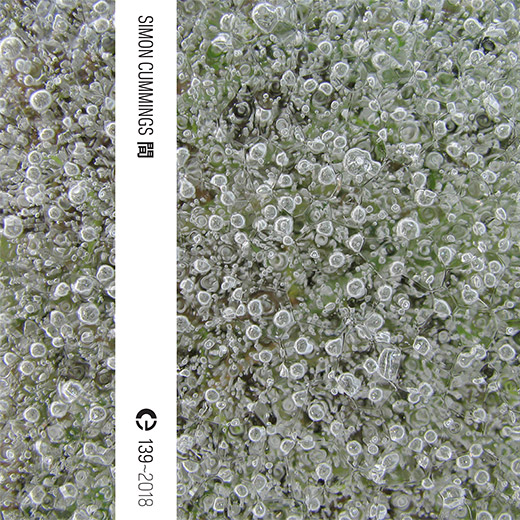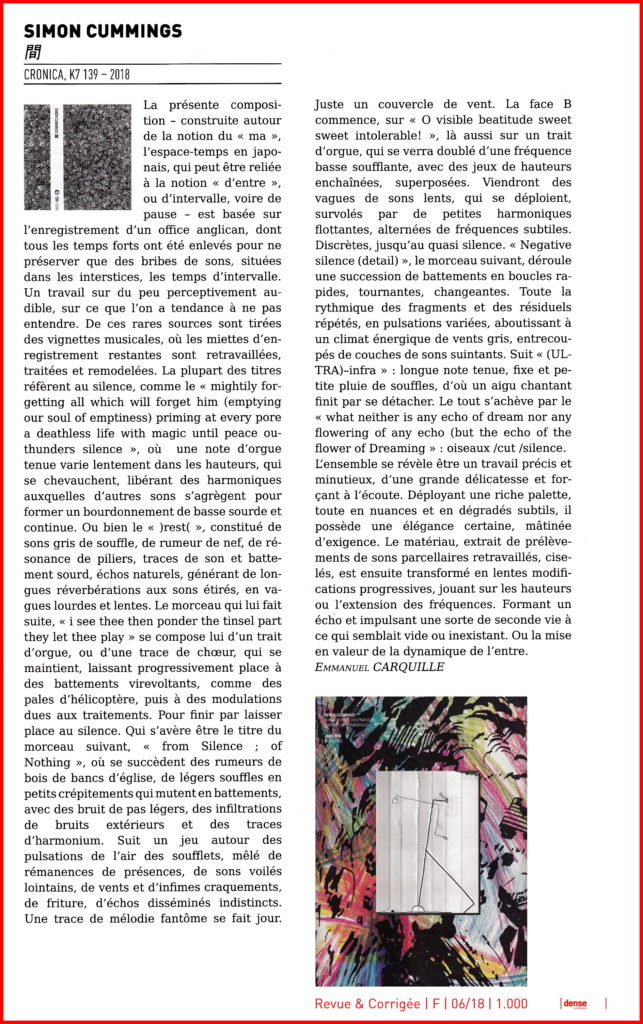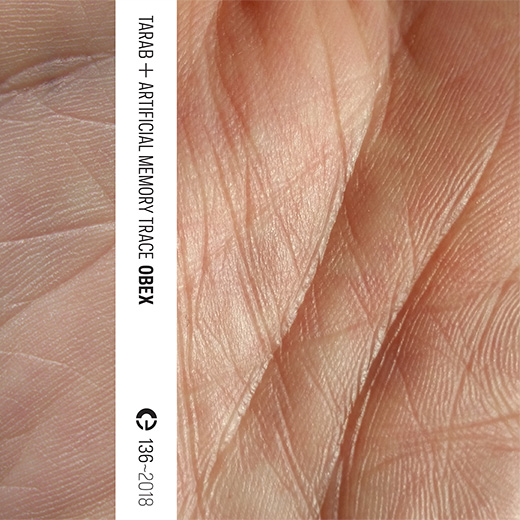Simon Cummings’s “間 (ma)†reviewed by Neural
Vacuamoenia’s “Panphonia†reviewed by A Closer Listen

Seeing, goes the theory, necessarily modifies what is being seen. That’s not even considering the effects of perspective, which is to say the mental articulation of meanings and associations in a particular language about whatever’s under observation. If field recording could be said to be in large part about enjoying the silence of the world, Vacuamoenia’s project turns that principle on its head, bringing the absence of the human to bear as a matrix upon which the meanings of the world’s silences rest. By means of a deep exploration of abandoned Sicilian villages mostly built during fascism’s period of hold over Italy, the collective comprised by an academic and a musician constantly suggest that listening is not as ‘passive’ as convention might dictate. Instead, listening is part of a communicative network that passes not only through the technical (equipment, positioning, and so on) and the personal (the artists’ criteria for selection) but also through the historical (music, after all, is all about time).
The main question, I believe, is what exactly shapes these sounds? The howling wind grazing the walls of empty rooms, the crackling of unseen objects moving, the drones emanating from materials contracting and expanding as the temperature rises and lowers, the distant buzz of storms funneled beneath crumbling archways and broken doors reclining upon rotting furniture… The naturalist stance, which treats these sounds as the interactions between objects, does not manage to cover the entire spectrum of their implications, which are born instead from the geographically specific mixtures of culture and history, interpreted and changed constantly by those of us who, even at a distance and through myriad mediations, listen with the intent to both experience and understand. Just like all these places, by virtue of being seen, are shifting in meaning, so do their sounds. Not in vain is the first track called “Chinmokuâ€, a Japanese word that conceptualizes a silence that does not break communication but is actually integral to it, the spaces between notes that make their very existence possible. The silence of these villages in decay is the source of both new and old landscapes, the dialogue between the vitality of the human-made with the vitality of the physical world taking back what the former has claimed.
“Panphoniaâ€, which basically means the “sound of everythingâ€, picks up water trickles and metallic pangs, a vast droning wind underlining the hollowness of these towns, a void paradoxically brimming with histories of violence, the emptiness a signal of their symbolic wealth. The “Music for a 24h Environment†takes a similar, cyclical approach to listening, which, like seeing, we never really stop doing, forever changing the meaning of the world around us. What shapes these sounds is not only the fallen fragments of buildings and the tree roots bursting from beneath the streets, it is also the processes behind them, the earthquakes and the economic crises, the hopes and the disappointments of a population in movement. In other words, it is a series of human absences, of silences, what truly produces an experience of the world’s meanings because there is, simply put, no world as it is. Panphonia, the sound of everything, serves as a reminder that even at a distance we constantly, irrevocably, participate. (David Murrieta Flores)
*Note: If you can read Spanish, I widely recommend reading this interview with the collective.
via A Closer Listen
Simon Cummings’s “間 (ma)†reviewed by Revue & Corrigée
Tarab + Artificial Memory Trace’s “Obex†reviewed by Revue & Corrigée
Monty Adkins’s “Moeror†reviewed by Ambientblog

With its 21’27†length this is not a full Monty Adkins album, but we will not complain about that – especially since Atkins and Crónica offer this single track EP as a free download (as they call it themselves, but I prefer Name Your Price and suggest to leave a donation to the artist and the label).
Moeror is Latin for ‘sorrow’ or ‘grief’, and is dedicated to the memory of Jóhann Jóhansson. There’s a nostalgic, contemplative piano theme looping over a slightly distorted noise background, but it’s not a repeating loop. At times, the loop changes, starts repeating a part of the theme. The material repeats, “sometimes exactly, at other times with additional processing or temporally shortened.â€
Adkins is examining and re-examining every single detail of the loop, over and over again, wondering why “repetition is so psychoemotionally enticing even in melancholic works.â€
The answer to that question is hidden in these timeless 22 minutes.
via Ambientblog
New release: Vacuamoenia’s “Panphoniaâ€

Panphonia is the sound of the everything, a circular whole that comes out and returns in the reality that generated it.
Panphonia is an electro-acoustic composition based on field recordings of a particular type of abandoned soundscape: the rural villages built during fascism in Sicily, the Borghi; the composition is born to consider as demiurgical actions the interior and exterior side of the matter:
Outside the body of the Borghi, the transient landscape re-occupies the place, lying on the border with a symphony of sounds whose body and shape are in the same materials that wreck the organs of the Borghi, the buildings that return to the earth. Thanks to the panoramic footage and the use of the contact microphones, a double representative dimension is combined in the composition, making the composer and the listener meet in a bridge that is the hub of the two worlds.
VacuaMœnia — from the Latin for empty walls — is a collective of Sicilian researchers investigating the sound environment, starting from the historical, anthropological, social, and bio-acoustical abandonment coordinates, reaching the consideration of the soundscape as a pictorial palette of sounds for assignment of new aesthetic meanings thanks to the medium of recording and electro-acoustic composition. VacuaMœnia was selected for Tempo Reale Collection “Sound at Work†and the symposium “Invisible Places†in Viseu (PT), it has taken part of the FKL Symposium in Oberhausen (DE), SAE Symposium in the University Of Kent (UK), Nuit Blanche in Paris (FR), Klingt Gut! in Hamburg (DE) and Sound and Memories at Goldsmith University (UK). They are currently developing a project for Manifesta, the Biennal of Contemporary Art in Palermo.
Panphonia is now available as a stream or download.
Soon in Crónica: Vacuamoenia’s “Panphoniaâ€

Tarab + Artificial Memory Trace’s “Obex†reviewed by Gonzo
Soon in Crónica: Vacuamoenia’s “Panphoniaâ€








